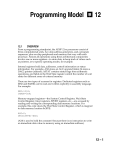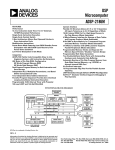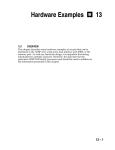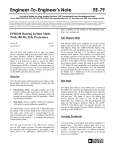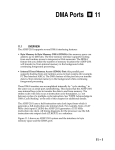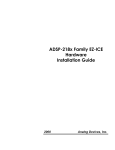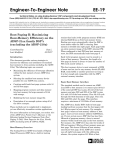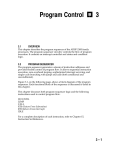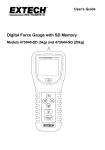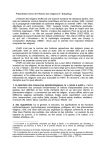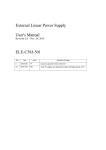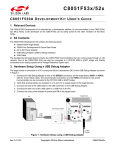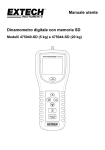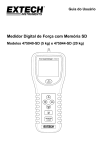Download ADSP-2100 Family User`s Manual, Host Interface Port
Transcript
Host Interface Port 7.1 7 OVERVIEW The host interface port (HIP) of the ADSP-2111, ADSP-2171, and ADSP-21msp58/59 is a parallel I/O port that allows these processors to be used as memory-mapped peripherals of a host computer (i.e. slave DSP processors). Examples of host computers include the Intel 8051, Motorola 68000 family, and even other ADSP-21xx processors. The host interface port can be thought of as an area of dual-ported memory, or mailbox registers, that allow communication between the host and the processor core of the ADSP-21xx. The host addresses the HIP as a segment of 8- or 16-bit words of memory. To the processor core, the HIP is a group of eight data-memory-mapped registers. Any number of ADSP-21xx processors can be used in parallel as memorymapped peripherals. Assigning a different address location to each one allows the host to control them all. The operating speed of the HIP is similar to that of the processor data bus. A read or write operation can occur within a single instruction cycle. Because the HIP is normally connected with devices that are much slower (the 68000, for example, can take four cycles to perform a bus operation), the data transfer rate is usually limited by the host computer. The host interface port is completely asynchronous to the rest of the ADSP-21xx’s operations. The host can write data to or read data from the HIP while the ADSP-21xx is operating at full speed. The HIP can be configured for operation on an 8-bit or 16-bit data bus and for either a multiplexed address/data bus or separate address and data buses. The ADSP-2111, ADSP-2171, and ADSP-21msp58/59 support two types of booting operations. One method boots from external memory (usually EPROM) using the boot memory interface described in the “Memory Interface” chapter. The other method uses the HIP to boot load a program from the host computer. HIP booting is described at the end of this chapter. 7–1 7 Host Interface Port 7.2 SUMMARY HIP PIN The HIP consists of 27 pins. As shown in Table 7.1, 16 of these are data pins and 11 are control pins. Some of the control pins have dual functions, allowing the processor to support different bus protocols. Pin Name Number of Pins Direction HSEL 1 Input HIP Select HACK 1 Output HIP Acknowledge HSIZE 1 Input HIP 8/16 Bit Host 0=16-bit; 1=8-bit BMODE 1 Input HIP Boot Mode Select 0=normal (EPROM); 1=HIP HMD0 1 Input HIP Bus Strobe Select 0=RD, WR; 1=RW, DS HRD/HRW * 1 Input HIP Read Strobe/ Read/Write Select HWR/HDS * 1 Input HIP Write Strobe/ Host Data Strobe HMD1 1 Input HIP Address/Data Mode 0=separate; 1=multiplexed HD15-0/HAD15-0 ** 16 Bidirectional HIP Data/Address & Data HA2 /ALE ** 1 Input HIP Host Address 2/ Address Latch Enable HA1-0/no function ** 2 Input Host Addresses 1 & 0 TOTAL 27 * HMD0 selects function ** HMD1 selects function Table 7.1 Host Interface Port Pins 7–2 Function Host Interface Port 7 HSEL is a host select which allows the host to enable or disable the HIP for host data transfers. HACK is a host acknowledge output for hosts that require an acknowledge for handshaking. HSIZE configures the bus size; the HIP can function in both 8-bit and 16bit modes. If the HIP is configured for an 8-bit host (HSIZE=1), data is read from and written to the lower eight bits of a HIP data register and the upper eight bits are zero-filled (on host writes) or tristated (on host reads). BMODE determines whether booting occurs through the HIP or through the memory interface pins. HMD0 and HMD1 are mode pins that configure the address, data and strobe pins, as shown in Table 7.2. HMD0 configures the bus strobes, selecting either separate read and write strobes or a single read/write select and a host data strobe. HMD1 configures the bus protocol, selecting either separate address (3-bit) and data (16-bit) buses or a multiplexed 16bit address/data bus with address latch enable. The timings of each of the four bus protocols are described later in this chapter. HMD1=0 HMD0=0 HMD0=1 HMD1=1 HRD HWR HD15-0 HA2-0 HIP Read Strobe HIP Write Strobe HIP Data HIP Address HRD HWR HAD15-0 ALE HIP Read Strobe HIP Write Strobe HIP Address/Data HIP Address Latch Enable HRW HDS HD15-0 HA2-0 HIP Read/Write Select HIP Data Strobe HIP Data HIP Address HRW HDS HAD15-0 ALE HIP Read/Write Select HIP Data Strobe HIP Address/Data HIP Address Latch Enable Table 7.2 HIP Configuration Modes 7– 3 7 Host Interface Port The functions of the following pins are determined by HMD0 and HMD1 as described above: HD15-0/HAD15-0 are either a data bus or a multiplexed address/data bus. (Only the 3 least significant address bits are used.) HRD/HRW is either a read strobe or a read/write select (1=read, 0=write). HWR/HDS is either a write strobe or a data strobe. HA2/ALE is either the most significant host address bit or an address latch enable. HA1-0 are either the two least significant host address bits or are unused. 7.3 FUNCTIONAL DESCRIPTION HIP The HIP consists of three functional blocks, shown in Figure 7.1: a host control interface block (HCI), a block of six data registers (HDR5-0) and a block of two status registers (HSR7-6). The HIP also includes an associated HMASK register for masking interrupts generated by the HIP. The HCI provides the control for reading and writing the host registers. The two status registers provide status information to both the host and the ADSP21xx core. The HIP data registers HDR5-0 are memory-mapped into internal data memory at locations 0x3FE0 (HDR0) to 0x3FE5 (HDR5). These registers can be thought of as a block of dual-ported memory. None of the HDRs are dedicated to either direction; they can be read or written by either the host or the ADSP-21xx. When the host reads an HDR register, a maskable HIP read interrupt is generated. When the host writes an HDR, a maskable HIP write interrupt is generated. The read/write status of the HDRs is also stored in the HSR registers. These status registers can be used to poll HDR status. Thus, data transfers through the HIP can be managed by using either interrupts or a polling scheme, described later in this chapter. 7–4 Host Interface Port 7 HSIZE BMODE HMD1 HMD0 HACK Boot Control Host Control Interface HSEL HWR/HDS HRD/HRW HA2/ALE HA1-0 2 Overwrite Bit 16 Read/write control DMD BUS HDR0 HDR1 HDR2 HDR3 HDR4 HMASK SOFT RESET HDR5 HSR6 HSR7 2 HIP INTERRUPTS 16 HD15-0 Figure 7.1 HIP Block Diagram The HSR registers are shown in Figure 7.2, which can be found on the following page. Status information in HSR6 and HSR7 shows which HDRs have been written. The lower byte of HSR6 shows which HDRs have been written by the host computer. The upper byte of the HSR6 shows which HDRs have been written by the ADSP-21xx. When an HDR register is read, the corresponding HSR bit is cleared. 7– 5 7 Host Interface Port HSR7 15 14 13 12 11 10 9 8 7 6 5 4 3 2 1 0 0 0 1 0 0 0 0 0 0 0 0 0 0 0 0 0 0x3FE7 21xx HDR0 Write 21xx HDR1 Write 21xx HDR2 Write OVERWRITE MODE 21xx HDR3 Write 21xx HDR4 Write SOFTWARE RESET HSR6 21xx HDR5 Write 15 14 13 12 11 10 9 8 7 6 5 4 3 2 1 0 0 0 0 0 0 0 0 0 0 0 0 0 0 0 0 0 0x3FE6 Host HDR0 Write Host HDR1 Write 21xx HDR5 Write Host HDR2 Write 21xx HDR4 Write Host HDR3 Write 21xx HDR3 Write Host HDR4 Write 21xx HDR2 Write Host HDR5 Write 21xx HDR1 Write 21xx HDR0 Write Figure 7.2 HIP Status Registers The lower six bits of HSR7 are copied from the upper byte of HSR6 so that 8-bit hosts can read both sets of status. Bits 7 and 6 of HSR7 control the overwrite mode and software reset, respectively; these functions are described later in this chapter. The upper byte of HSR7 is reserved. All reserved bits and the software reset bit read as zeros. The overwrite bit is the only bit in the HSRs that can be both written and read. At reset, all HSR bits are zeros except for the overwrite bit, which is a one. 7.4 HIP OPERATION The ADSP-21xx core can place a data value into one of the HDRs for retrieval by the host computer. Similarly, the host computer can place a data value into one of the HDRs for retrieval by the ADSP-21xx. To the host computer, the HDRs function as a section of memory. To the ADSP-21xx, the HDRs are memory-mapped registers, part of the internal data memory space. 7–6 Host Interface Port 7 Because the HIP typically communicates with a host computer that has both a slower instruction rate and a multicycle bus cycle, the host computer is usually the limiting factor in the speed of HIP transfers. During a transfer, the ADSP-21xx executes instructions normally, independent of HIP operation. This is true even during a multicycle transfer from the host. For host computers that require handshaking, the ADSP-21xx returns HACK in the same cycle as the host access, except in overwrite mode. In overwrite mode, the ADSP-21xx can extend a host access by not asserting the HACK acknowledge until the cycle is complete. The user can enable and disable overwrite mode by setting and clearing a bit in HSR7. Overwrite mode is described in more detail later in this chapter. The HDRs are not initialized during either hardware or software reset. The host can write information to the HDRs before a reset, and the ADSP21xx can read this information after the reset is finished. During reset, however, HIP transfers cannot occur; the HACK pin is deasserted and the data pins are tristated. Because a host computer that requires handshaking must wait for an acknowledgement from the ADSP-21xx, it is possible to cause such a host to hang. If, when the host has initiated a transfer, but has not yet received an acknowledgement, the ADSP-21xx is reset, then the acknowledgement can not be generated, thus causing the host to wait indefinitely. There is no hardware in the HIP to prevent the host from writing a register that the ADSP-21xx core is reading (or vice versa). If the host and the ADSP-21xx try to write the same register at the same time, the host takes precedence. Simultaneous writes should be avoided, however: since the ADSP-21xx and the host operate asynchronously, simultaneous writes can cause unpredictable results. 7.4.1 Polled Operation Polling is one method of transferring data between the host and the ADSP-21xx. Every time the host writes to an HDR, a bit is automatically set in the lower byte of HSR6. This bit remains set until the ADSP-21xx reads the HDR. Similarly, when the ADSP-21xx writes to an HDR, a bit in the upper byte of HSR6 (and the lower byte of HSR7) is set. This bit is cleared automatically when the host reads the HDR. 7– 7 7 Host Interface Port For example, the ADSP-21xx can wait in a loop reading an HSR bit to see if the host has written new data. When the ADSP-21xx sees that the bit is set, it conditionally jumps out of the loop, processes the new data, then returns to the loop. When transferring data to the host, the ADSP-21xx waits for the host to read the last data written so that new data can be transferred. The host polls the HSR bits to see when the new data is available. 7.4.1.1 HIP Status Synchronization Processes running on the ADSP-21xx are asynchronous to processes running on the host. Values in the shared status registers (HSR6, HSR7) can therefore change at any time, and reading a changing value could give unpredictable results. The ADSP-21xx HIP, however, includes synchronization circuitry which guarantees that the HIP status is constant during a read by either the ADSP-21xx core or the host. This synchronization is illustrated in Figures 7.3 and 7.4. The status registers are updated by the ADSP-21xx and thus are synchronous with the ADSP21xx processor clock, but host accesses are asynchronous with respect to the ADSP-21xx clock. When the host reads HSR6 or HSR7 to obtain status information, there is a one-cycle synchronization delay before the current (i.e. updated) status is available. To obtain the correct, current status, therefore, the host must perform Host Access HCLK d1 status change d2 status change Host Access c1 c2 host status update Figure 7.3 Host Status Synchronization CLKOUT d1 status change d2 status change c1 21xx HIP status update Figure 7.4 ADSP-21xx HIP Status Synchronization 7–8 c2 21xx HIP status update host status update Host Interface Port 7 two consecutive reads—the second read will generate the correct status information (the first read generates the previous status). In Figure 7.3, host status synchronization is based on a pseudo-clock HCLK, internal to the ADSP-21xx, which is a logical combination of HRD, HWR and HSEL. The first event shown in the figure is a status change at d1. The host status will then be updated after the HCLK low, HCLK high, HCLK low sequence at point c1. A status change at d2 would wait for the HCLK low, HCLK high, HCLK low sequence, and then host status would be updated at point c2. Status synchronization for the ADSP-21xx requires one full CLKOUT cycle (starting at the rising edge) after a status change. As shown in Figure 7.4, a status change at point d1 would cause a 21xx HIP status update at c1. A status change at d2 would cause a 21xx HIP status update at c2. 7.4.2 Interrupt-Driven Operation Using an interrupt-driven protocol frees the host and the ADSP-21xx from polling the HSR(s) to see when data is ready to be read. For interrupt-driven transfers to the ADSP-21xx, the host writes data into an HDR, and the HIP automatically generates an internal interrupt. The interrupt is serviced like any other interrupt. For transfers to the host, the ADSP-21xx writes data to an HDR, then sets a flag output, which is connected to a host interrupt input, to signal the host that new data is ready to be transferred. Flag outputs are discussed in detail in Chapter 9, “System Interface.” If the ADSP-21xx passes data to the host through only one HDR, then that HDR can be read directly by the host when it receives the interrupt. If more than one HDR is used to pass data, then the host must read the appropriate HSR(s) to determine which HDR was written by the ADSP-21xx. 7.4.3 HDR Overwrite Mode In most cases, the ADSP-21xx reads host data sent through the HIP faster than the host can send them. However, if the host is sufficiently fast, if the ADSP-21xx is busy, or if the ADSP-21xx is driven by a slow clock, there may be a delay in servicing a host write interrupt. If the host computer uses a handshaking protocol requiring the ADSP-21xx to assert HACK to complete a host transfer, the ADSP-21xx can optionally hold off the next host write until it has processed the current one. If the HDR overwrite bit (bit 7 in HSR7) is cleared, and if the host tries to write to a register before it has been read by the ADSP-21xx, HACK is not asserted until the ADSP-21xx has read the previously written data. The host processor must wait for HACK to be asserted. As described earlier, however, there is a delay from when the host writes data to when the status is synchronized to the ADSP-21xx. During this interval, it is possible for the host to write an HDR a second time even when the overwrite bit is cleared. 7– 9 7 Host Interface Port If the HDR overwrite bit is set, the previous value in the HDR is overwritten and HACK is returned immediately. If the ADSP-21xx is reading the register that is being overwritten, the result is unpredictable. After reset, the HDR overwrite bit is set. If the host does not require an acknowledge (HACK is not used), the HDR overwrite bit should be always be set, because there is no way for the ADSP-21xx to prevent overwrite. 7.4.4 Software Reset Writing a 1 to bit 6 of HSR7 causes software reset of the ADSP-21xx. If the ADSP-21xx writes the software reset bit, the reset happens immediately. Otherwise, the reset happens as soon as the write is synchronized to the ADSP-21xx system clock. The internal software reset signal is held for five ADSP-21xx clock cycles and then released. 7.5 INTERRUPTS HIP HIP interrupts can be masked using either the IMASK register or the HMASK register. Bits in the IMASK register enable or disable all HIP read interrupts or all HIP write interrupts. The HMASK register, on the other hand, has bits for masking the generation of read and write interrupts for individual HDRs. In order for a read or write of an HDR to cause an interrupt, the HIP read or write interrupt must be enabled in IMASK, and the read or write to the particular HDR must be enabled in HMASK. HMASK is mapped to memory location 0x3FE8. IMASK is described in Chapter 3, “Program Control.” A host write interrupt is generated whenever the host completes a write to an HDR. A host read interrupt is generated when an HDR is ready to receive data from the ADSP-21xx—this occurs when the host has read the previous data, and also after reset, before the ADSP-21xx has written any data to the HDR. HMASK, however masks all HIP interrupts at reset. The read interrupt allows the ADSP-21xx to transfer data to the host at a high rate without tying up the ADSP-21xx with polling overhead. HMASK allows reads and writes of some HDRs to not generate interrupts. For example, a system might use HDR2 and HDR1 for data values and HDR0 for a command value. Host write interrupts from HDR2 and HDR1 would be masked off, but the write interrupt from HDR0 would be unmasked, so that when the host wrote a command value, the ADSP-21xx would process the command. In this way, the overhead of servicing 7 – 10 Host Interface Port 7 HMASK 15 14 13 12 11 10 9 8 7 6 5 4 3 2 1 0 0 0 0 0 0 0 0 0 0 0 0 0 0 0 0 0 0x3FE8 Host HDR0 Write Host HDR1 Write Host HDR5 Read Host HDR2 Write Host HDR4 Read Host HDR3 Write Host HDR3 Read Host HDR4 Write Host HDR2 Read Host HDR5 Write Host HDR1 Read Host HDR0 Read Figure 7.5 HMASK Register INTERRUPT ENABLES 1=enable 0=disable interrupts when the host writes data values is avoided. The HMASK register is organized in the same way as HSR6; the mask bit is in the same location as the status bit for the corresponding register. The lower byte of HMASK masks host write interrupts and the upper byte masks host read interrupts. The bits are all positive sense (0=masked, 1=enabled). HMASK is mapped to the internal data memory space at location 0x3FE8. At reset, the HMASK register is all zeros, which means that all HIP interrupts are masked. HIP read and write interrupts are not cleared by servicing such an interrupt. Reading the HDR clears a write interrupt, and writing the HDR clears a read interrupt. The logical combination of all read and write interrupt requests generates a HIP interrupt. Pending interrupt requests remain until all HIP interrupts are cleared by either reading or writing the appropriate HIP data register. If the ADSP-21xx is reading registers that the host might be writing, it is not certain that an interrupt will be generated. To ensure that all host writes generate interrupts, you must make sure that the ADSP-21xx is not reading the HDRs that the host is writing. While servicing the interrupt, the status register can be read to determine which operation generated the interrupt and whether multiple interrupt requests need to be serviced. HIP interrupts cannot be forced or cleared by software, as other interrupts can. The HIP write interrupt vector is location 0x0008. The HIP read interrupt vector is location 0x000C. 7– 11 7 Host Interface Port 7.6 INTERFACE TIMING HOST The following diagrams show the timings of HIP signals in the various modes determined by HMD0 and HMD1. HMD0 configures the bus strobes, selecting either separate read and write strobes or a single read/ write select and a host data strobe. HMD1 configures the bus protocol, selecting either separate address (3-bit) and data (16-bit) buses or a multiplexed 16-bit address/data bus with address latch enable. The HSIZE pin can be changed on a cycle-by-cycle basis; although not shown in the following diagrams, it has the same timing as the HRD/HRW signal. Figure 7.6 shows the HIP timing when both HMD0=0 and HMD1=0. HA2–0 ADDRESS HSEL Host Write Cycle HWR HACK HD15–0 HA2–0 DATA ADDRESS HSEL Host Read Cycle HRD HACK HD15–0 DATA Figure 7.6 HIP Timing: Separate Strobes, Separate Buses 7 – 12 Host Interface Port 7 HMD0 selects separate read and write strobes, and HMD1 selects separate address and data buses. The timing for the read cycle and the write cycle is as follows: 1. 2. 3. 4. 5. 6. 7. The host asserts the address. The host asserts (HRD or HWR) and HSEL. The ADSP-21xx returns HACK (and, for a read cycle, the data). For a write cycle, the host asserts the data. The host deasserts (HRD or HWR) and HSEL. The host deasserts the address (and, for a write cycle, the data). The ADSP-21xx deasserts HACK (and, for a read cycle, the data). Figure 7.7 shows the HIP timing when HMD0=1 and HMD1=0. HMD0 HA2–0 ADDRESS HSEL HRW Host Write Cycle HDS HACK HD15–0 HA2–0 DATA ADDRESS HSEL HRW Host Read Cycle HDS HACK HD15–0 DATA Figure 7.7 HIP Timing: Multiplexed R/W Strobe, Separate Buses 7– 13 7 Host Interface Port selects a multiplexed read/write select with data strobe, and HMD1 selects separate address and data buses. The timing for the read cycle and the write cycle is as follows: 1. 2. 3. 4. 5. 6. 7. The host asserts HRW and the address. The host asserts HDS and HSEL. The ADSP-21xx returns HACK (and, for a read cycle, the data). For a write cycle, the host asserts the data. The host deasserts HDS and HSEL. The host deasserts HRW and the address (and, for a write cycle, the data). The ADSP-21xx deasserts HACK (and, for a read cycle, the data). Figure 7.8 shows the HIP timing when HMD0=0 and HMD1=1. HMD0 selects separate read and write strobes, and HMD1 selects multiplexed address and data buses. HD0-HD2 are used for the address. The timing ALE HSEL Host Write Cycle HWR HACK HAD15–0 ADDRESS DATA ALE HSEL Host Read Cycle HRD HACK HAD15–0 ADDRESS DATA Figure 7.8 HIP Timing: Separate Strobes, Multiplexed Buses 7 – 14 Host Interface Port 7 for the read cycle and the write cycle is as follows: 1. 2. 3. 4. 5. 6. 7. 8. 9. 10. The host asserts ALE. The host drives the address. The host deasserts ALE. The host stops driving the address. The host asserts (HRD or HWR) and HSEL. The ADSP-21xx returns HACK (and, for a read cycle, the data). For a write cycle, the host asserts the data. The host deasserts (HRD or HWR) and HSEL. For a write cycle, the host deasserts the data. The ADSP-21xx deasserts HACK (and, for a read cycle, the data). Figure 7.9 shows the HIP timing when HMD0=1 and HMD1=1. HMD0 selects a multiplexed read/write select with data strobe, and HMD1 selects multiplexed address and data buses. HD0-HD2 are used for the address. The timingALE for the read cycle and the write cycle is as follows: HSEL HRW Host Write Cycle HDS HACK HAD15–0 ADDRESS DATA ALE HSEL HRW Host Read Cycle HDS HACK HAD15–0 ADDRESS DATA Figure 7.9 HIP Timing: Multiplexed R/W Strobe, Multiplexed Buses 7– 15 7 Host Interface Port 1. 2. 3. 4. 5. 6. 7. 8. 9. 10. 11. The host asserts ALE. The host drives the address. The host deasserts ALE. The host stops driving the address. The host asserts HRW. The host asserts HDS and HSEL. The ADSP-21xx returns HACK (and, for a read cycle, the data). For a write cycle, the host asserts the data. The host deasserts HDS and HSEL. The host deasserts HRW (and, for a write cycle, the data). The ADSP-21xx deasserts HACK (and, for a read cycle, the data). 7.7 THROUGH THE HIP BOOT LOADING The entire internal program RAM of the ADSP-21xx, or any portion of it, can be loaded using a boot sequence. Upon hardware or software reset, the boot sequence occurs if the MMAP pin is 0. If the MMAP pin is 1, the boot sequence does not occur. The ADSP-21xx can boot in either of two ways: from external memory (usually EPROM), through the boot memory interface, or from a host processor, through the HIP. The BMODE pin selects which type of booting occurs. When BMODE=0, booting occurs through the memory interface. This process is described in Chapter 10, “Memory Interface.” When the BMODE=1, booting occurs through the HIP. To generate a file for HIP booting, use the HIP Splitter utility program of the ADSP-2100 Family Development Software. (This utility produces HIP boot files while the PROM Splitter utility produces files for EPROM booting.) The BMS signal is asserted when booting through the HIP just as when booting through the memory interface; in this case, it serves as an indication that the boot sequence is occurring. Boot memory wait states have no effect when booting through the HIP. Booting through the HIP occurs in the following sequence: 1. After reset, the host writes the length of the boot sequence to HDR3. 7 – 16 Host Interface Port 7 2. The host waits at least two ADSP-21xx processor cycles. 3. Starting with the instruction which is to be loaded into the highest address of internal program memory, the host writes an instruction into HDR0, HDR2 and HDR1 (in that order), one byte each. The upper byte goes into HDR0, the lower byte goes into HDR2 and the middle byte goes into HDR1. 4. The address of the instruction is decremented, and Step 3 is repeated. This continues until the last instruction has been loaded into the HIP. The ADSP-21xx reads the length of the boot load first, then bytes are loaded from the highest address downwards. This results in shorter booting times for shorter loads. The number of instructions booted must be a multiple of eight. The boot length value is given as: length = (number of 24-bit program memory words ÷ 8) – 1 That is, a length of 0 causes the HIP to load eight 24-bit words. In most cases, no handshaking is necessary, and the host can transfer data at the maximum rate it is capable of. If the host operates faster than the ADSP-21xx, wait states or NOPs must be added to the host cycle to slow it down to one write every ADSP-21xx clock cycle. 7– 17 7 Host Interface Port The following example shows the data that a host would write to the HIP for a 1000-instruction boot: Data Location Page Length (124 decimal) HDR3 Upper Byte of Instruction at 999 Lower Byte of Instruction at 999 Middle Byte of Instruction at 999 HDR0 HDR2 HDR1 Upper Byte of Instruction at 998 Lower Byte of Instruction at 998 Middle Byte of Instruction at 998 HDR0 HDR2 HDR1 Upper Byte of Instruction at 997 Lower Byte of Instruction at 997 Middle Byte of Instruction at 997 HDR0 HDR2 HDR1 • • • • • • Upper Byte of Instruction at 0 Lower Byte of Instruction at 0 Middle Byte of Instruction at 0 HDR0 HDR2 HDR1 A 16-bit host boots the ADSP-21xx at the same rate as an 8-bit host. Either type of host must write the same data to the same the HDRs in the same sequence (HDR0, HDR2, HDR1). If a 16-bit host writes 16-bit data, the upper byte of the data must be 0x00. The following example, loading the instruction 0xABCDEF, illustrates this: 1st Write (to HDR0) 2nd Write (to HDR2) 3rd Write (to HDR1) 7 – 18 8-Bit Host 0xAB 0xEF 0xCD 16-Bit Host 0x00AB 0x00EF 0x00CD



















